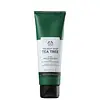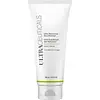What's inside
What's inside
 Key Ingredients
Key Ingredients

 Benefits
Benefits

 Concerns
Concerns

 Ingredients Side-by-side
Ingredients Side-by-side

Water
Skin ConditioningKaolin
AbrasiveGlycerin
HumectantPropanediol
SolventMagnesium Aluminum Silicate
AbsorbentPerlite
AbsorbentXanthan Gum
EmulsifyingCocamidopropyl Betaine
CleansingSodium Laureth Sulfate
CleansingDecyl Glucoside
CleansingPEG-7 Glyceryl Cocoate
EmulsifyingAlcohol Denat.
AntimicrobialPhenoxyethanol
PreservativeHydrogenated Jojoba Wax
Melaleuca Alternifolia Leaf Oil
AntioxidantSodium Chloride
MaskingCitric Acid
BufferingSalicylic Acid
MaskingCalophyllum Inophyllum Seed Oil
AntimicrobialMenthol
MaskingEthylhexylglycerin
Skin ConditioningTrisodium Ethylenediamine Disuccinate
Sodium Benzoate
MaskingTetrasodium Pyrophosphate
BufferingLeptospermum Petersonii Oil
MaskingCitral
PerfumingPhosphoric Acid
BufferingTocopherol
AntioxidantCI 77891
Cosmetic ColorantCI 77499
Cosmetic ColorantWater, Kaolin, Glycerin, Propanediol, Magnesium Aluminum Silicate, Perlite, Xanthan Gum, Cocamidopropyl Betaine, Sodium Laureth Sulfate, Decyl Glucoside, PEG-7 Glyceryl Cocoate, Alcohol Denat., Phenoxyethanol, Hydrogenated Jojoba Wax, Melaleuca Alternifolia Leaf Oil, Sodium Chloride, Citric Acid, Salicylic Acid, Calophyllum Inophyllum Seed Oil, Menthol, Ethylhexylglycerin, Trisodium Ethylenediamine Disuccinate, Sodium Benzoate, Tetrasodium Pyrophosphate, Leptospermum Petersonii Oil, Citral, Phosphoric Acid, Tocopherol, CI 77891, CI 77499
Water
Skin ConditioningGlycerin
HumectantCocamidopropyl Betaine
CleansingPEG-120 Methyl Glucose Trioleate
CleansingSodium Lauroyl Sarcosinate
CleansingDecyl Glucoside
CleansingMagnesium Aluminum Silicate
AbsorbentOlive Oil PEG-7 Esters
EmollientGlycol Distearate
EmollientSodium Chloride
MaskingSodium Lauroyl Lactylate
EmulsifyingAvena Sativa Kernel Flour
AbrasivePropanediol
SolventLaureth-4
EmulsifyingXanthan Gum
EmulsifyingPanthenol
Skin ConditioningTocopheryl Acetate
AntioxidantCucumis Sativus Fruit Extract
EmollientCitrus Grandis Peel Oil
MaskingSalicylic Acid
MaskingCitric Acid
BufferingDisodium EDTA
Sodium Benzoate
MaskingTetrasodium EDTA
Sorbic Acid
PreservativeBenzyl Alcohol
PerfumingAloe Barbadensis Leaf Juice Powder
Skin ConditioningFormic Acid
PreservativeMaltodextrin
AbsorbentPotassium Sorbate
PreservativeSodium Hydroxide
BufferingLimonene
PerfumingWater, Glycerin, Cocamidopropyl Betaine, PEG-120 Methyl Glucose Trioleate, Sodium Lauroyl Sarcosinate, Decyl Glucoside, Magnesium Aluminum Silicate, Olive Oil PEG-7 Esters, Glycol Distearate, Sodium Chloride, Sodium Lauroyl Lactylate, Avena Sativa Kernel Flour, Propanediol, Laureth-4, Xanthan Gum, Panthenol, Tocopheryl Acetate, Cucumis Sativus Fruit Extract, Citrus Grandis Peel Oil, Salicylic Acid, Citric Acid, Disodium EDTA, Sodium Benzoate, Tetrasodium EDTA, Sorbic Acid, Benzyl Alcohol, Aloe Barbadensis Leaf Juice Powder, Formic Acid, Maltodextrin, Potassium Sorbate, Sodium Hydroxide, Limonene
Ingredients Explained
These ingredients are found in both products.
Ingredients higher up in an ingredient list are typically present in a larger amount.
Citric Acid is an alpha hydroxy acid (AHA) naturally found in citrus fruits like oranges, lemons, and limes.
Like other AHAs, citric acid can exfoliate skin by breaking down the bonds that hold dead skin cells together. This helps reveal smoother and brighter skin underneath.
However, this exfoliating effect only happens at high concentrations (20%) which can be hard to find in cosmetic products.
Due to this, citric acid is usually included in small amounts as a pH adjuster. This helps keep products slightly more acidic and compatible with skin's natural pH.
In skincare formulas, citric acid can:
While it can provide some skin benefits, research shows lactic acid and glycolic acid are generally more effective and less irritating exfoliants.
Most citric acid used in skincare today is made by fermenting sugars (usually from molasses). This synthetic version is identical to the natural citrus form but easier to stabilize and use in formulations.
Read more about some other popular AHA's here:
Learn more about Citric AcidCocamidopropyl Betaine is a fatty acid created by mixing similar compounds in coconut oil and dimethylaminopropylamine, a compound with two amino groups.
This ingredient is a surfactant and cleanser. It helps gather the dirt, pollutants, and other impurities in your skin to be washed away. It also helps thicken a product and make the texture more creamy.
Being created from coconut oil means Cocamidopropyl Betaine is hydrating for the skin.
While Cocamidopropyl Betaine was believed to be an allergen, a study from 2012 disproved this. It found two compounds in unpure Cocamidopropyl Betaine to be the irritants: aminoamide and 3-dimethylaminopropylamine. High-grade and pure Cocamidopropyl Betaine did not induce allergic reactions during this study.
Learn more about Cocamidopropyl BetaineDecyl Glucoside is a glucose-based surfactant and emulsion stabilizer. It is created by reacting glucose with the fatty acids from plants.
Surfactants help clean the skin by trapping oil, sebum, and dirt to be washed away. As an emulsion stabilizer, it stabilizes the ingredients in a product by preventing them from separating.
This ingredient is biodegradable and non-toxic. This ingredient is commonly found in baby shampoos.
Decyl Glucoside is sometimes used to stabilize the UV filter Tinosorb.
Learn more about Decyl GlucosideGlycerin is already naturally found in your skin. It helps moisturize and protect your skin.
A study from 2016 found glycerin to be more effective as a humectant than AHAs and hyaluronic acid.
As a humectant, it helps the skin stay hydrated by pulling moisture to your skin. The low molecular weight of glycerin allows it to pull moisture into the deeper layers of your skin.
Hydrated skin improves your skin barrier; Your skin barrier helps protect against irritants and bacteria.
Glycerin has also been found to have antimicrobial and antiviral properties. Due to these properties, glycerin is often used in wound and burn treatments.
In cosmetics, glycerin is usually derived from plants such as soybean or palm. However, it can also be sourced from animals, such as tallow or animal fat.
This ingredient is organic, colorless, odorless, and non-toxic.
Glycerin is the name for this ingredient in American English. British English uses Glycerol/Glycerine.
Learn more about GlycerinMagnesium Aluminum Silicate is a type of silica. It comes from naturally occuring minerals such as silicate ores and clay.
Magnesium aluminum silicate is used for enhancing texture and as an absorbent. Due to its large molecular size, it is unable to be absorbed into the skin.
Like other types of silica, this ingredient can be used to thicken a product. As an absorbent, it may be used to absorb extra water or help prevent clumping.
Although “aluminum” in an ingredient name can raise red flags for some consumers, the form and usage context matter significantly. For typical topical applications, there is no substantial evidence of health risks - such as cancer, neurotoxicity, or systemic “aluminum overload.”
Learn more about Magnesium Aluminum SilicatePropanediol is an all-star ingredient. It softens, hydrates, and smooths the skin.
It’s often used to:
Propanediol is not likely to cause sensitivity and considered safe to use. It is derived from corn or petroleum with a clear color and no scent.
Learn more about PropanediolSalicylic Acid (also known as beta hydroxy acid or BHA) is a well-known ingredient for treating skin that struggles with acne and clogged pores. It exfoliates both the skin's surface and deep within the pores to help clear out buildup, control oil, and reduce inflammation.
Unlike AHAs (alpha hydroxy acids), salicylic acid is oil-soluble. This allows it to penetrate into pores which makes it especially effective for treating blackheads and preventing future breakouts.
Salicylic acid is also known for its soothing properties. It has a similar structure to aspirin and can calm inflamed or irritated skin, making it a good option for acne-prone skin that is also sensitive.
Concentrations of 0.5-2% are recognized by the U.S. FDA as an over-the-counter topical acne product.
It can cause irritation and/or dryness if one's skin already has a compromised moisture barrier, so it's best to focus on repairing that before introducing this ingredient into your routine.
While salicylic acid does not increase sun sensitivity, it’s still important to wear sunscreen daily to protect your skin.
If you are looking for the ingredient called BHA or Butylated Hydroxyanisole, click here.
Learn more about Salicylic AcidSodium Benzoate is a preservative. It's used in both cosmetic and food products to inhibit the growth of mold and bacteria. It is typically produced synthetically.
Both the US FDA and EU Health Committee have approved the use of sodium benzoate. In the US, levels of 0.1% (of the total product) are allowed.
Sodium benzoate works as a preservative by inhibiting the growth of bacteria inside of cells. It prevents the cell from fermenting a type of sugar using an enzyme called phosphofructokinase.
It is the salt of benzoic acid. Foods containing sodium benzoate include soda, salad dressings, condiments, fruit juices, wines, and snack foods.
Studies for using ascorbic acid and sodium benzoate in cosmetics are lacking, especially in skincare routines with multiple steps.
We always recommend speaking with a professional, such as a dermatologist, if you have any concerns.
Learn more about Sodium BenzoateChances are, you eat sodium chloride every day. Sodium Chloride is also known as table salt.
This ingredient has many purposes in skincare: thickener, emulsifier, and exfoliator.
You'll most likely find this ingredient in cleansers where it is used to create a gel-like texture. As an emulsifier, it also prevents ingredients from separating.
There is much debate on whether this ingredient is comedogenic. The short answer - comedogenic ratings don't tell the whole story. Learn more about comegodenic ratings here.
The concensus about this ingredient causing acne seems to be divided. Research is needed to understand if this ingredient does cause acne.
Scrubs may use salt as the primary exfoliating ingredient.
Learn more about Sodium ChlorideWater. It's the most common cosmetic ingredient of all. You'll usually see it at the top of ingredient lists, meaning that it makes up the largest part of the product.
So why is it so popular? Water most often acts as a solvent - this means that it helps dissolve other ingredients into the formulation.
You'll also recognize water as that liquid we all need to stay alive. If you see this, drink a glass of water. Stay hydrated!
Learn more about WaterXanthan gum is used as a stabilizer and thickener within cosmetic products. It helps give products a sticky, thick feeling - preventing them from being too runny.
On the technical side of things, xanthan gum is a polysaccharide - a combination consisting of multiple sugar molecules bonded together.
Xanthan gum is a pretty common and great ingredient. It is a natural, non-toxic, non-irritating ingredient that is also commonly used in food products.
Learn more about Xanthan Gum